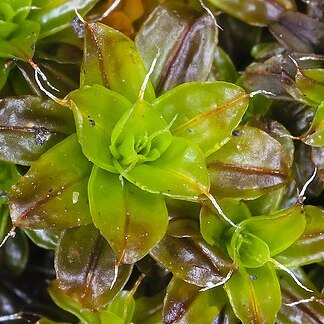Plants large, in dense tufts, green to yellow-brown; terricolous. Stems 10-30 mm high, branching, tomentose below; in section with central strand, cortical cells lax, becoming smaller toward margin, yellowish red. Leaves appressed, keeled, little contorted dry, erect to widespreading wet; broadly lingulate to spathulate, 3-4 mm long; apex obtusely acute to retuse; margins narrowly revolute below, plane above. Costa long-excurrent as hyaline awn, 1-2 mm long, weakly denticulate; ventral superficial cells quadrate, thin-walled, papillose, dorsal superficial cells elongate, strongly incrassate, smooth; in section guide cells 2, ventral cells in 1-2 layers, surface cells papillose, dorsal stereid band large, 4-5 cells thick, dorsal surface cells undifferentiated, smooth. Laminal cells quadrate to hexagonal, densely papillose, with 4-8 C-or O-shaped papillae over both surfaces; basal cells large, in well defined group, rectangular, hyaline, smooth. Synoicous. Perichaetia terminal, leaves undifferentiated. Seta 15-20 mm long, red-brown; capsule cylindrical, 3-4 mm long, red-brown; peristome reddish yellow to white, 0.8-1.0 mm high, teeth papillose, filamentous above a high, obliquely tessellated basal membrane; operculum conical, 1.0-1.5 mm long; spores round, 10-15 µm, almost smooth.
More
Stems 5-20 mm. Leaves usually in distinct whorls, infolded, somewhat contorted, and weakly to strongly twisted around the stem when dry, wide-spreading to slightly recurved when moist, concave, spatulate, 2-4 × 1-1.5 mm; margins revolute in the proximal 1/2-3/4, entire; apices acute or sometimes truncate; costa excurrent into a long, serrate, hyaline awn (reddish at base), often strongly papillose abaxially and serrulate near the apex because of projecting cell ends, red; basal cells abruptly differentiated, long-rectangular, 45-80 × 20-30 µm, short-rectangular to quadrate at the margins; distal cells quadrate to hexagonal, 12-17 µm, slightly bulging, bearing 4-6 papillae per cell. Specialized asexual reproduction absent. Sexual condition synoicous (apparently rarely dioicous). Seta red, 10-18 mm. Capsule brownish red, 3-4 mm, slightly curved, with a distinct neck; operculum 1.5-2 mm, brown; peristome ca. 1.5 mm, the distal divisions twisted about 2 turns, red, the basal membrane white, 1/2-2/3 the total length. Spores 9-13 µm, papillose.

